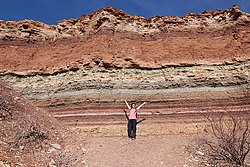
Back طبقة (جيولوجيا) Arabic Estratu AST Lay (təbəqə) Azerbaijani Пласт (геалогія) Byelorussian Пласт (геалёгія) BE-X-OLD Пласт (геология) Bulgarian Estrat (geologia) Catalan چین (زەویناسی) CKB Vrstva (geologie) Czech Сий (геологи) CV
This article needs additional citations for verification. (May 2018) |


In geology and related fields, a stratum (pl.: strata) is a layer of rock or sediment characterized by certain lithologic properties or attributes that distinguish it from adjacent layers from which it is separated by visible surfaces known as either bedding surfaces or bedding planes.[1] Prior to the publication of the International Stratigraphic Guide,[1] older publications have defined a stratum as being either equivalent to a single bed or composed of a number of beds; as a layer greater than 1 cm in thickness and constituting a part of a bed; or a general term that includes both bed and lamina.[2] Related terms are substrate and substratum (pl.substrata), a stratum underlying another stratum.
- ^ a b Salvador, A. ed., 1994. International stratigraphic guide: a guide to stratigraphic classification, terminology, and procedure. 2nd ed. Boulder, Colorado, The Geological Society of America, Inc., 215 pp. ISBN 978-0-8137-5216-7.
- ^ Neuendorf, K.K.E., Mehl, Jr., J.P., and Jackson, J.A. , eds., 2005. Glossary of Geology 5th ed. Alexandria, Virginia, American Geological Institute. 779 pp. ISBN 0-922152-76-4.